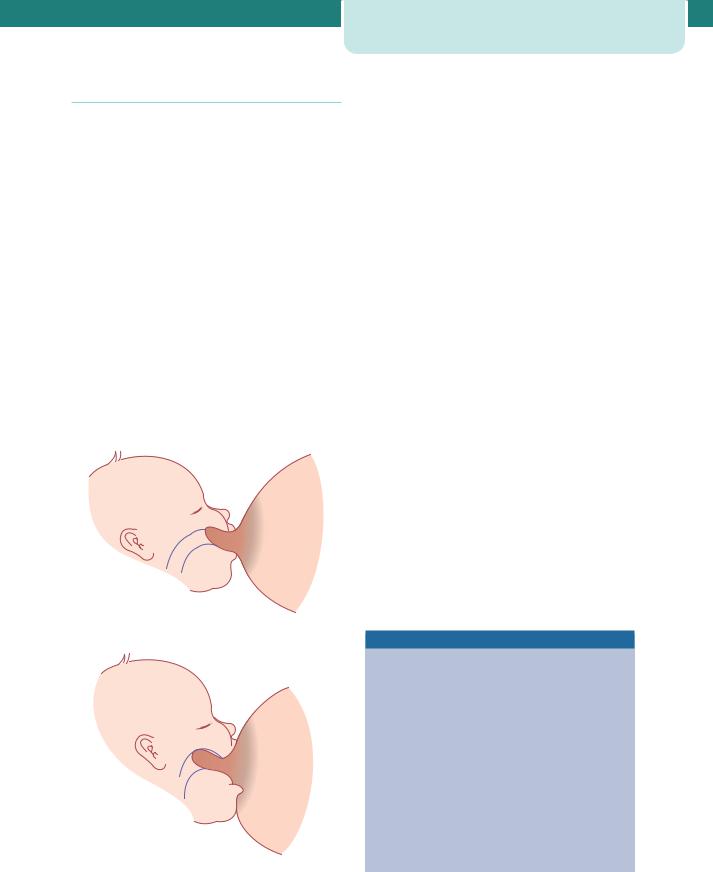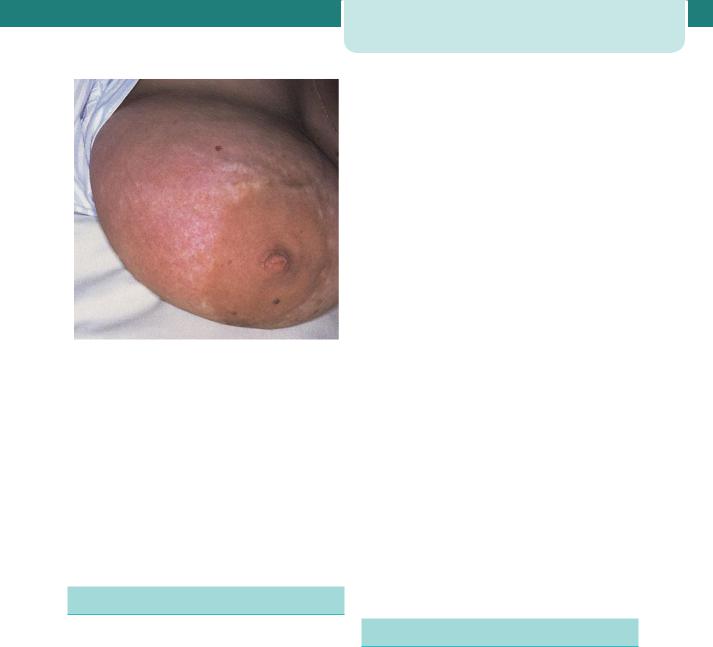
Obstetrics_by_Ten_Teachers_19E_-_Kenny_Louise
.pdf
266The puerperium
preparation for secretory activity. The lactogenic hormones prolactin and human placental lactogen probably modulate these changes during pregnancy.
Colostrum
Colostrum is a yellowish fluid secreted by the breast that can be expressed as early as the 16th week of pregnancy, but is replaced by milk during the second postpartum day. Colostrum has a high concentration of proteins but contains less sugar and fat than breast milk, although it contains large fat globules. The proteins are mainly in the form of globulins, particularly immunoglobulin (Ig) A, which plays an important role in protection against infection. Colostrum is also believed to have a laxative effect, which may help empty the baby’s bowel of meconium.
Breast milk
The major constituents of breast milk are lactose, protein, fat and water (Table 17.3). However, the composition of breast milk is not constant; early lactation differs from late lactation, one feed differs from the next, and the composition can even change during a feed. Artificial infant formulas cannot therefore be identical to breast milk. Compared to cow’s milk, breast milk provides slightly more energy, has less protein but more fat and lactose. The major protein fractions are lactalbumin, lactoglobulin and caseinogen. Lactalbumin is the major protein in breast milk, whereas caseinogen forms 90 per cent of the protein in cow’s milk. The mineral content (particularly sodium) is much higher in cow’s milk, which can therefore be dangerous if given to a baby who is dehydrated from gastroenteritis. In addition to IgA, breast milk contains small amounts of IgM and IgG and other factors such as lactoferrin, macrophages, complement and lysozymes. Although breast milk contains a lower concentration of iron, its absorption is better than from cow’s milk or ironsupplemented infant formula ( 75 per cent, 30 per cent and 10 per cent, respectively). The improved bioavailability may be related to lactoferrin, an ironbinding glycoprotein, which also inhibits bacterial growth. With the exception of vitamin K, all other vitamins are found in breast milk and therefore vitamin K is given to the baby to minimize the risk of haemorrhagic disease (see Chapter 19, Neonatology).
Table 17.3 Comparison between human and cow’s milk
|
Human |
Cow’s |
|
breast milk |
milk |
Energy (kcal/mL) |
75 |
66 |
Lactose (g/100 mL) |
6.8 |
4.9 |
|
|
|
Protein (g/100 mL) |
1.1 |
3.5 |
|
|
|
Fat (g/100 mL) |
4.5 |
3.7 |
|
|
|
Sodium (mmol/L) |
7 |
22 |
|
|
|
Water (mL/100 mL) |
87.1 |
87.3 |
Prolactin
Prolactin is a long-chain polypeptide produced from the anterior pituitary; levels rise up to 20-fold during pregnancy and lactation. Peak levels of prolactin are reached within 45 minutes of suckling, but return to normal immediately after weaning and in nonbreastfeeding mothers. The exact mechanism of action is not fully understood, but prolactin appears to have a direct action on the secretory cells to synthesize milk proteins. Prolactin is essential for lactation and it is hypothesized that nipple stimulation prevents the release of prolactin-inhibiting factor from the hypothalamus, thereby initiating the production of prolactin by the anterior pituitary. This theory is supported by the fact that lactation can be arrested with bromocryptine, a dopamine agonist that inhibits prolactin. A similar phenomenon occurs following pituitary necrosis (Sheehan’s syndrome) when prolactin production ceases.
Oxytocin
Once milk has been produced under the influence of prolactin, it has to be delivered to the infant. The milkejection or let-down reflex is initiated by suckling, which stimulates the pulsatile release of oxytocin from the posterior pituitary. Oxytocin contracts the myoepithelial cells surrounding the alveoli, as well as the myoepithelial cells lying longitudinally along the lactiferous ducts, thereby aiding the expulsion of milk. Oxytocin release can also be stimulated by visual, olfactory or auditory stimuli, e.g. hearing the baby cry, but can be inhibited by stress. Oxytocin can also stimulate uterine contractions, giving rise to the ‘after-pains’ of childbirth.

Breastfeeding
Women who opt to breastfeed tend to decide before or very early in their pregnancy. This decision is usually based on previous experience, influence of family or friends, culture and custom. A new mother who is unprepared for breastfeeding may find it a frustrating task and turn to bottle-feeding. There is now evidence to suggest that antenatal classes and literature on breastfeeding given antenatally may be beneficial.
The most common reasons mothers give for abandoning breastfeeding are inadequate milk production and sore and cracked nipples. Both these problems can be overcome by correct positioning of the baby on the breast (Figure 17.3). The mouth should be placed over the nipple and areola so that suction created within the baby’s mouth draws the breast tissue into a teat which extends as far back as the junction of the soft and hard palate. The tongue applies peristaltic force to the underside of the teat against the support of the hard palate. In this way,
(a)
(b)
Figure 17.3 (a) Poor positioning. (b) Good positioning
The breasts |
267 |
there should be no to-and-fro movement of the teat in and out of the baby’s mouth, thus minimizing friction. The mother should also be taught how to implement the rooting reflex. When the skin around the baby’s mouth is touched, the mouth begins to gape. At this point, the mother should reposition the baby so that the lower rim of the baby’s mouth fits well below the nipple, allowing a liberal mouthful of breast tissue. When the baby is properly attached, breastfeeding should be pain free. The use of creams and ointments for cracked nipples has not been shown to be beneficial and the use of a nipple shield merely reduces milk production.
Although no study has identified the threshold of the critical time limit for successful breastfeeding, early suckling appears to be beneficial. However, this should not be rushed, and perhaps should be done initially under supervision when the mother is comfortable and in privacy.
There is no scientific evidence to justify a rigid breastfeeding schedule. Babies should be fed on demand and left on the breast until feeding finishes spontaneously. An imposed time limit on feeding can have a deleterious effect on calorie intake.
Supplementary feeds of formula, glucose or water are often given to breastfed infants in the belief that the baby is still hungry or thirsty. However, this is a misconception, as this practice merely increases the risk of total abandonment of breastfeeding.
Test-weighing infants before and after a feed to establish the ideal quantity of milk intake is an archaic practice that should be abandoned, as inappropriate action could prove hazardous.
Advantages of breastfeeding
•Readily available at the right temperature and ideal nutritional value.
•Cheaper than formula feed.
•Associated with a reduction in:
•childhood infective illnesses, especially gastroenteritis,
•fertility with amenorrhoea,
•atopic illnesses, e.g. eczema and asthma,
•necrotizing enterocolitis in preterm babies,
•juvenile diabetes,
•childhood cancer, especially lymphoma,
•pre-menopausal breast cancer.

268 The puerperium
Non-breastfeeding mothers
There are various reasons why a woman may choose not to breastfeed, ranging from personal choice to stillbirth. Previously, women infected with HIV were discouraged from breastfeeding. The most recent recommendations from the World Health Organization reflect an understanding that the risk of vertical transmission of HIV via breastfeeding is less than the risk of death by malnutrition or sepsis for the majority of infants who have to rely on formula feeds in developing countries.
Non-breastfeeding mothers may suffer considerable engorgement and breast pain. Dopamine receptor stimulants, such as bromocryptine and cabergoline, inhibit prolactin and thus suppress lactation. However, both have been associated with an increased risk of hypertension and stroke. Furthermore, fluid restriction and a tight brassiere have been shown to be equally effective as bromocryptine usage by the second week and therefore this is the method of choice for the suppression of lactation.
Breast disorders
Blood-stained nipple discharge
Blood-stained nipple discharge of pregnancy is typically bilateral and believed to be due to epithelial proliferation. It usually occurs in the second or third trimester of pregnancy and rarely persists beyond three months postpartum. As the condition is selflimiting, no investigation or treatment is necessary, and the woman should be reassured.
Painful nipples
The nipple can become very painful if the covering epithelium is denuded or if a fissure develops giving rise to ‘cracked nipples’. The cause is usually attributed to poor positioning of the baby on the breast, although thrush (candidiasis) may also cause soreness. Cracked nipples are also associated with an increased risk of a breast abscess developing. Treatment involves resting the affected nipple and manually expressing milk. Breastfeeding should then be reintroduced gradually.
Galactocele
A galactocele is a retention cyst of the mammary ducts following blockage by inspissated secretions. It is identified as a fluctuant swelling with minimal pain and inflammation. It usually resolves spontaneously but may also be aspirated; with increasing discomfort, surgical excision may become necessary.
Breast engorgement
Engorgement of the breasts usually begins by the second or third postpartum day and if breastfeeding has not been effectively established, the over-distended and engorged breasts can be very uncomfortable. Breast engorgement may give rise to puerperal fever of up to 39ºC in 13 per cent of mothers. Although the fever rarely lasts more than 16 hours, other infective causes must be excluded. A number of remedies for the treatment of breast engorgement, such as manual expression, firm support, applying an ice bag and an electric breast pump, have all been recommended in the past, but allowing the baby easy access to the breast is the most effective method of treatment and prevention.
Mastitis
Inflammation of the breast is not always due to an infective process. Mastitis can occur when a blocked duct obstructs the flow of milk and distends the alveoli. If this pressure persists, the milk extravasates into the perilobular tissue, initiating an inflammatory process. The affected segment of the breast is painful and appears red and oedematous (Figure 17.4). Flulike symptoms develop associated with a tachycardia and pyrexia. In the first few postpartum days, about 15 per cent of women will develop a temperature of up to 39ºC, lasting less than 24 hours, due to breast engorgement. By contrast, in infective mastitis, the pyrexia develops later and persists for longer. In general, suppurative mastitis usually presents in the third to fourth postpartum week and is usually unilateral. Symptoms include rigors, fever, pain and reddened, swollen breasts. The most common infecting organism is Staphylococcus aureus, which is found in 40 per cent of women with mastitis. Other bacteria include coagulase-negative staphylococci and Streptococcus viridans. The most common sources of infection are, first, from the baby’s nose or throat and,

Figure 17.4 Mastitis demonstrating redness, oedema and engorged veins
second, from an infected umbilical cord. Management includes isolation of the mother and baby, ceasing breastfeeding from the affected breast, expression of milk either manually or by electric pump, and microbiological culture and sensitivity of a sample of milk. Flucloxacillin can be commenced while awaiting sensitivity results.
About 10 per cent of women with mastitis develop a breast abscess. Treatment is by a radial surgical incision and drainage under general anaesthesia.
Contraception
The exact mechanism of lactational amenorrhoea is poorly understood, but the most plausible hypothesis is that during lactation there is inhibition of the normal pulsatile release of luteinizing hormone from the anterior pituitary. Breastfeeding therefore provides a contraceptive effect, but it is not totally reliable, as up to 10 per cent of women conceive during this period. However, it has recently been shown that a mother who is still in the phase of postpartum amenorrhoea while fully breastfeeding her baby has a less than 2 per cent chance of conceiving in the first six months. Although this is comparable to some other forms of contraception (see Chapter 7, Gynaecology by Ten Teachers, 18th edn), most women in developed countries use some sort of additional contraception, such as barrier methods. If an intrauterine
Pelvic floor exercises |
269 |
contraceptive device is preferred, it is best to wait at least 4–8 weeks to allow for involution. Care needs to be exercised in breastfeeding mothers, as there have been reports of increased rates of uterine perforation. The combined oral contraceptive pill enhances the risk of thrombosis in the early puerperium and can have an adverse effect on the quality and constituents of breast milk. The progesterone-only pill (the minipill) is therefore preferable and should be commenced about day 21 following delivery, prior to which there may be puerperal breakthrough bleeding. Injectable contraception, such as depot medroxyprogesterone acetate (Depo-Provera) given three-monthly or norethisterone enantate (Noristerat) given two-monthly, is also very effective. However, injectable contraception given within 48 hours of delivery for convenience can cause breakthrough bleeding and therefore should preferably be given 5–6 weeks postpartum.
Sterilization can be offered to mothers who are certain that they have completed their family. Tubal ligation can be performed during Caesarean section or by the open method (mini-laparotomy) in the first few postpartum days. However, it is better delayed until after 6 weeks postpartum, when it can be done by laparoscopy. This allows the mother to spend more time in comfort with her newborn baby and, furthermore, laparoscopic clip sterilization is less traumatic and associated with a lower failure rate.
Women who are not breastfeeding should commence the pill within 4 weeks of delivery, as ovulation can occur by 6 weeks postpartum.
Pelvic floor exercises
It is a widespread belief that pelvic floor exercises tone up the muscles of the pelvic floor and should therefore be advocated in the postpartum period. However, large randomized trials to evaluate their benefit in preventing genital prolapse, urinary incontinence or anal incontinence are lacking. There is also no evidence that antenatal exercises prevent incontinence or prolapse. However, as general exercise is known to strengthen striated muscle, and pelvic floor exercises are unlikely to be harmful, women are still taught post-natal exercises. This should also serve to cultivate a feeling of pelvic floor awareness, so that women with pelvic floor dysfunction seek medical help sooner.

270 The puerperium
Perinatal death
•Stillbirth: a baby born with no signs of life
•Perinatal death: stillbirth 24 weeks gestation or death within 7 days of birth
•Live birth: any baby that shows signs of life irrespective of gestation.
Bereavement counselling following perinatal death requires special expertise and is best left to a senior clinician and a trained bereavement counsellor. Inappropriate management of this traumatic period can have a devastating effect on the woman’s emotional and marital life. Effective communication and support are crucial and women should be encouraged to make contact with organizations, such as SANDS (Stillbirth and Neonatal Death Society).
The grieving process can be facilitated by practices such as seeing and holding the dead baby, naming the baby, and taking hand/foot prints and photographs. Coming to terms with the perinatal death of a twin is even more difficult because the mother has to mourn one baby and celebrate the arrival of the other.
A post-mortem is the most important diagnostic test, even though there may be no positive findings. Couples who decline a post-mortem may do so because of religious reasons or because they fear mutilation. In this situation, a partial post-mortem should be discussed whereby an autopsy of a single
Table 17.4 Investigations into perinatal death
Investigations
organ or a tissue biopsy can be performed. A full-body x-ray or, preferably, magnetic resonance imaging (MRI) may be useful in some cases (Table 17.4).
If the baby was stillborn, a stillbirth certificate should be completed by the attending doctor; otherwise, the paediatrician should complete the certificate. The certificate should be given to the parents to register the death with the Registrar of Births and Deaths. Funeral arrangements can be made privately or by the hospital.
Every mother who has lost a baby should have the 6-week post-natal visit at hospital.
The post-natal examination
This is carried out at about 6 weeks postpartum by the general practitioner or by the obstetrician if delivery had been complicated. The examination includes an assessment of the woman’s mental and physical health, as well as the progress of the baby. In particular, direct questions must be asked about urinary, bowel and sexual function. Incontinence and dyspareunia are embarrassing issues that women do not volunteer to discuss readily. Weight, urine analysis and blood pressure are checked and a complete general, abdominal and pelvic examination is performed. If a cervical smear is due, it can be taken, although it is preferable to take one after three months postpartum. Contraception and pelvic floor exercises are also discussed.
Reason
Full blood count |
Anaemia, leukocytosis |
Clotting screen |
Disseminated intravascular coagulation |
Kleihauer test |
Fetomaternal transfusion |
|
|
Virology, infection screen |
Cytomegalovirus, parvovirus |
|
|
Autoantibody screen (anti-cardiolipin and lupus |
Antiphospholipid syndrome, systemic lupus |
anticoagulant) |
erythematosus |
Blood and placenta culture |
Infections such as Listeria monocytogenes |
|
|
Antibodies in rhesus-negative women |
Haemolytic disease |
|
|
Toxoplasma antibodies |
Toxoplasmosis |
|
|
Skin biopsy/cardiac blood/placental biopsy |
Chromosome analysis |
Full-body x-ray or MRI |
To identify congenital defects |
|
|
MRI, magnetic resonance imaging.

|
|
Perinatal death |
271 |
C A S E H I S T O R Y
An 18-year-old woman with a BMI of 35 who had a forceps delivery after a prolonged second stage of labour 8 days previously presented with heavy, fresh vaginal bleeding and clots. She felt unwell and complained of abdominal cramps.
On examination, she had a temperature of 38.2ºC and there was mild suprapubic tenderness. Vaginal examination revealed blood clots, but no products of conception. The cervix admitted only the tip of a finger and the uterus was tender and measured 14 weeks in size. A review of the delivery notes revealed that the placenta was delivered complete, but the membranes were noted to be ragged.
What is the most likely diagnosis?
Secondary PPH due to endometritis or infected retained products of conception.
What are the most relevant risk factors?
•Obesity.
•Prolonged labour.
•Instrumental delivery.
How should the patient be managed?
•Blood cultures.
•Intravenous broad-spectrum antibiotics, e.g. cephalosporin and metronidazole.
•Although a pelvic ultrasound may confirm the diagnosis, it has the potential to mislead and is not a prerequisite when the diagnosis is obvious.
•Surgical evacuation of retained products in the uterus.
Key points
•The puerperium refers to the 6-week period following childbirth.
•Care during this transition period is crucial before the woman returns to her pre-pregnant state.
•Perineal discomfort is a major complaint following vaginal delivery and therefore adequate analgesia should be prescribed.
•Common disorders include puerperal sepsis, thromboembolism, bowel and bladder dysfunction.

|
|
|
|
|
|
|
|
|
|
|
|
|
|
|
|
C H A P T E R 1 8 |
P S Y C H I A T R I C D I S O R D E R S A N D |
||||||||||||
|
|
|
T H E P U E R P E R I U M |
|
|
|||||||||
|
|
|
Alec McEwan |
|
|
|
|
|
|
|
|
|||
|
|
|
|
|
|
|
||||||||
|
The significance of mental ill health to pregnancy, |
|
|
Management of pregnancy in women with |
|
|
||||||||
|
childbirth and motherhood |
|
|
272 |
|
|
pre-existing psychiatric disease.......................................... |
274 |
|
|||||
|
Normal emotional and psychological changes |
|
|
New-onset psychiatric disease in pregnancy....................... |
277 |
|
||||||||
|
during pregnancy .......................................................................... |
|
|
273 |
|
Understanding the pathophysiology of postpartum |
|
|
||||||
|
Screening for mental health problems during |
|
|
|
affective disorders ........................................................................ |
280 |
|
|||||||
|
and after pregnancy .................................................................... |
|
|
273 |
|
|
|
|
|
|
|
|
|
|
|
|
|
|
|
|
|
|
|
|
|
|
|
|
|
O V E R V I E W
Overall, the incidence of mild mental health problems is not significantly different during pregnancy, although the risk of developing an antepartum serious new-onset psychiatric disorder is reduced. However, the risk of bipolar or severe depressive illness is greatly increased postpartum. Women with previous serious mental health problems are at high risk of a recurrence during both the antepartum and postpartum periods. It is vital for all healthcare professionals providing maternity and psychiatric care to understand how pregnancy may interact with mental health and to understand key themes in the detection of those at risk, and their subsequent management during and after the pregnancy. A multidisciplinary approach, supervised by specialist perinatal mental health teams, is vital to optimize care, limit morbidity and help prevent the tragic cases detailed in the maternal mortality reports. The problems of substance and alcohol misuse during pregnancy overlap significantly with mental health issues, and coordination is required between specialist services and providers of maternity care.
The significance of mental ill health to
pregnancy, childbirth and motherhood
Childbirth contributes a substantial risk to the mental health of women. Although the antenatal period is not generally considered a high-risk time for the onset of new severe psychiatric disease, milder disorders do affect a significant minority of pregnant women (see Table 18.1) and up to a third of women presenting with severe depression in the antepartum period have no previous history. However, in the year following childbirth, women who were previously well have a greatly elevated risk of being admitted to a psychiatric hospital, being referred to a psychiatrist, suffering from a psychotic illness or developing severe depression. This risk is higher than their lifetime risk, and is much greater than for other women, or men. More than 80 per cent of women with postpartum psychiatric disease will be suffering from their first-ever psychiatric illness.
Pregnant women with pre-existing mental illness, or those who book with a previous history, are at significant risk of an antenatal or post-natal recurrence or exacerbation. Pregnancy, childbirth and the stresses of life as a new parent may destabilize conditions that had previously been under control. Certain pharmacological treatments may be contraindicated in pregnancy and suitable alternatives have to be found. Optimizing the new relationship between mother and baby may require help from specialist services.
The impact of psychiatric disease in pregnancy has been emphasized repeatedly by the Confidential Enquiries into Maternal and Child Health (CEMACH). The most recent report, ‘Saving mothers’ lives’, covers the triennium 2003–5. It reports on 37 suicides occurring during pregnancy, or within one year of delivery. Most suicides occurred in association with post-natal mental illness. A further 22 women died from overdose of drugs of abuse, of which at least six

Table 18.1 Incidence of postpartum mental disorders
Depression |
15–30% |
Major depressive illness |
10% |
|
|
Moderate/severe depressive illness |
3–5% |
|
|
Referral to a psychiatrist |
2% |
|
|
Admission to a psychiatric unit |
0.4% |
Admission with puerperal psychosis |
0.2% |
|
|
may have been intentional, rather than accidental. Of special note, suicide during pregnancy is unusually violent (shootings, hangings), in contrast with suicide attempts in younger women, which commonly take the form of overdose and are less frequently successful. This emphasizes the severity of mental health problems occurring after delivery, when most maternal suicides take place. The number of suicides has fallen since the last triennium and it is hoped that recommendations made in these reports are having a positive impact.
Psychiatric disease is also commonly found in cases of violent maternal death. Life-threatening medical disorders may arise as a direct result of substance misuse, or may be misdiagnosed as perinatal mental health problems leading to delay in appropriate treatment, and, in some cases, death.
Pregnancy therefore impacts significantly on the incidence and presentation of psychiatric disorders, but it also poses unique treatment challenges. The safety of the fetus must also be considered, and the focus of therapy may ideally be away from drug treatments and toward psychological alternatives. However, failure to treat mental health issues rapidly may put both mother and baby at greater risk and drug treatment is often required. Strategies which are safe for the fetus are best recommended by specialist perinatal psychiatrists with particular skills in this field.
Normal emotional and psychological
changes during pregnancy
Diagnosing mental illness in pregnancy is complicated by the wide variety of ‘normal’ emotional and behavioural changes which may occur. Common patterns include the following:
•Antenatal
• mixed feelings about being pregnant
Screening for mental health problems |
273 |
during and after pregnancy |
|
•fears of being unable to cope
•increased emotional lability
•minor depressive symptoms (most marked in the first trimester)
•anxiety and fears regarding delivery
•obsessional thoughts regarding the safety of the baby (more common in the third trimester,
particularly in women who have specific pregnancy complications).
•Post-natal
•The ‘pinks’: for the first 24–48 hours following delivery, it is very common for women to
experience an elevation of mood, a feeling of excitement, some overactivity and difficulty sleeping.
•The ‘blues’: as many as 80 per cent of women may experience the ‘post-natal blues’ in the
first 2 weeks after delivery. Fatigue, short temperedness, difficulty sleeping, depressed mood and tearfulness are common but usually mild, and resolve spontaneously in the majority of cases.
The following psychological disruptions should not be considered normal during pregnancy and require further assessment:
•panic attacks;
•episodes of low mood of prolonged duration ( 2 weeks);
•low self-esteem;
•guilt or hopelessness;
•thoughts of self-harm or suicide;
•any mood changes that disrupt normal social functioning;
•‘biological’ symptoms (e.g. poor appetite, early wakening);
•change in ‘affect’.
Screening for mental health problems
during and after pregnancy
Not all mental illness associated with pregnancy is predictable, however, identifiable risk factors do exist, as do screening methods designed to detect early psychiatric disease. Prophylactic treatments and

274 Psychiatric disorders and the puerperium
management strategies can be instituted to prevent the onset of symptoms, or detect problems at an earlier and more easily treatable stage. It is the responsibility of all healthcare professionals looking after pregnant women to identify these risk factors, institute plans of surveillance and care, and refer to specialist services where necessary.
The National Institute for Health and Clinical Excellence (NICE) Clinical Guideline No. 45 ‘Antenatal and postnatal mental health’ sets out screening questions that all pregnant women should be asked (Table 18.2). If the answers to these questions raise concerns, then the woman should be referred back to her GP, to her own psychiatrist, if she has one, or to a specialist perinatal mental health team depending on the severity of the symptoms or previous history.
Management of pregnancy in women
with pre-existing psychiatric disease
Women with pre-existing mental health issues usually come to the attention of the maternity services at booking and appropriate screening questions should form part of all routine booking histories, as detailed in Table 18.2. Ideally, women with pre-existing psychiatric problems should receive pre-pregnancy counselling from a specialist in perinatal mental health. Issues to discuss include the impact of the pregnancy on the condition and the risk of relapse or deterioration. The longterm capacity for successful parenthood must be considered for women with schizophrenia, and other severe illnesses. Attention must be paid to the safety of medications during pregnancy, and the risk of relapse if they are withdrawn before conception. To minimize the risk of harm to the fetus from exposure to psychotropic drugs,
Table 18.2 Screening questions for mental health during and after pregnancy
At ‘booking’ (with midwife, GP or hospital obstetrician):
Is there a past history of severe mental illness (including schizophrenia, bipolar disorder, postpartum psychosis and severe depression)?
Have you ever received treatment from a psychiatrist or specialist mental health team?
Have you ever been admitted as an inpatient for psychiatric care?
Do you have a family history of mental health problems, particularly perinatal or bipolar illness?
At booking, and in the post-natal period (at least twice):
During the past month, have you often felt down, depressed or hopeless?
During the past month, have you often been bothered by having little interest or pleasure in doing things?
Are these feelings something you need or want help with?
the threshold for psychological treatments should be lower and access to these treatments should be straightforward. The mental health services should be involved at an early point in the pregnancies of women who have either ongoing disease or a past history of significant mental illness. Women requiring inpatient care during or after pregnancy should ideally be admitted to specialized regional ‘mother-and-baby’ units.
C A S E 1
A 28-year-old woman with obsessive-compulsive disorder |
preoccupied with her body image and these concerns |
had successfully been treated by her psychiatrist with a |
intensified as the pregnancy became more noticeable. She |
combination of psychotherapy and the SSRI, paroxetine. She |
was spending excessive amounts of time in front of mirrors and |
had recently married and approached her doctor for pre-pregnancy |
could not be reassured by her midwife that her appearance was |
advice. Paroxetine was gradually withdrawn in view of its |
normal. Her psychiatrist suggested cognitive–behavioural therapy |
teratogenic properties. She remained well and conceived seven |
and a brief course seemed to help keep her symptoms under |
months later. During the pregnancy, she became increasingly |
control. |

|
|
|
|
|
|
|
Management of pregnancy in women |
275 |
|
|
|
with pre-existing psychiatric disease |
|
|
|
|
|
|
|
|
She managed well through labour, however, she deteriorated |
became necessary, fluoxetine was chosen over the more typical |
|
|
|
in the post-natal period, becoming severely obsessive about |
choices of citalopram or clomipramine because the quantities |
|
|
|
cleanliness and the risks of infection to her new baby. Repeated |
reaching breast milk are less. She continued this treatment |
|
|
|
handwashing and checking of electricity switches and gas cooker |
for a further 12 months and was gradually withdrawn from the |
|
|
|
knobs began to interfere with normal post-natal routines. She |
medication thereafter. |
|
|
|
was successfully breastfeeding and, when medications finally |
|
|
|
|
|
|
|
|
Depression
At least one in ten women will suffer some form of depression throughout their lifetime. There is no evidence that pregnancy reduces the risk of a relapse or improves the mood of women with active depression. Depression has a negative impact on pregnancy outcomes by adversely affecting diet, attendance for antenatal care, levels of smoking, alcohol consumption, self-harm and domestic violence. Existing family relationships suffer, and bonding with a new baby may be incomplete. There are biological reasons why depression might directly impact on placental function and predispose to fetal growth restriction and preterm labour.
Psychological treatments, including selfhelp approaches, cognitive–behavioural therapy, counselling and interpersonal psychotherapy may replace or supplement drug treatment. Withdrawing medication risks causing a relapse, but this may be possible under supervision. Alternatively, drug therapies can be minimized, rationalized, or safer alternatives used. There is ample experience with the use of tricyclic antidepressant drugs (TCAs) during pregnancy and women can be reassured that they carry no teratogenic risk and that they are safe to take while breastfeeding. The situation with selective serotonin reuptake inhibitors (SSRIs) is less clear. Studies have shown a possible increase in the number of congenital abnormalities with certain preparations, and a link with increased risk of preterm labour and low birthweight. However, their use in younger women is increasing. Minimization of the dose of all antidepressant drugs in the late third trimester will limit the levels in the newborn infant and help to prevent anticholinergic,
serotonergic and extrapyramidal side effects in the neonate. Electroconvulsive therapy is not absolutely contraindicated in pregnancy, and may be needed in catatonic states.
Women with a history of severe depression not related to pregnancy carry between a 1:3 and 1:5 risk of a major postpartum depressive illness. If the previous depression occurred in the postpartum period, the recurrence risk is as high as 50 per cent. At the very least, skilled monitoring should be planned for the post-natal period. Prophylactic medications should also be considered.
Schizophrenia
Although older antipsychotic medications may have impaired fertility, this is not the case with newer drugs. Women with schizophrenia may be at greater risk of unplanned pregnancies as a result of their illness. Fluphenazine, trifluoperazine, haloperidol, chlorpromazine and flupenthixol do not have convincing teratogenic effects and the risks to the woman of stopping these drugs suddenly, with the real risk of disease relapse, are considered greater than any theoretical risks of fetal exposure. Under the guidance of a mental health specialist, it may be possible to reduce the dose in the third trimester to minimize levels in the newborn and prevent symptoms of withdrawal or toxicity.
Pre-pregnancy counselling is particularly important. Schizophrenia may seriously limit parenting skills and there is a significant risk that an affected mother will not ultimately remain the primary carer of her own child. Extra social support and surveillance will usually be necessary, but this is often tolerated poorly by affected individuals. Schizophrenia
